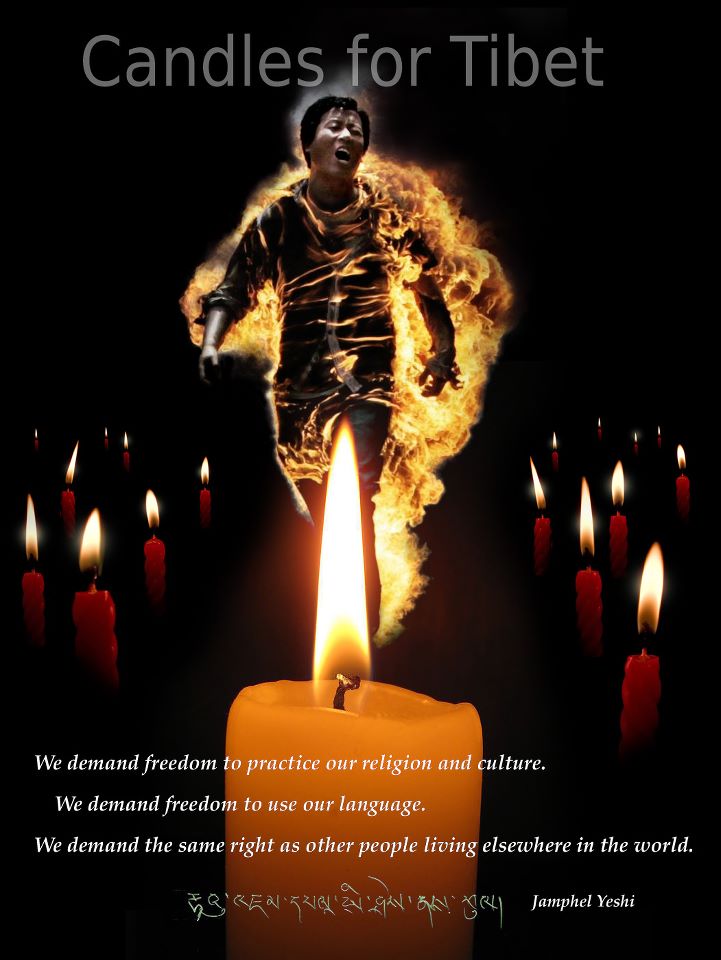
Tibet burns
Why Tibet burns
By Maura Moyniha, published on Deccan Chronicle
When Chinese Premier Hu Jintao flew into New Delhi for the Brics Summit recently, he careened onto unfamiliar terrain: a democracy with a free press, where a 27-year-old Tibetan refugee, Jampa Yeshi, walked to a public protest, poured kerosene over his body and set himself on fire whilst shouting for an end to Chinese atrocities in Tibet. The searing images from India of Jampa Yeshi’s burning body exposed to the world the cost of China’s reign of terror in Tibet, which has been well concealed for 61 years.
I have just returned from interviewing Tibetan refugees in India, a mission that began when I first lived in India in the early 1970s, and I can attest that after 53 years in exile, Tibetans are increasingly frustrated and desperate. To date, 32 people inside Tibet have set themselves alight in public, in defiance of Chinese Communist assaults on their Buddhist faith, but there are no journalists or diplomats to bear witness to the carnage, only raw video that reaches the Internet. But there is another potent source of this explosion of Tibetan outrage which receives negligible international coverage; the covert history of China’s rape and pillage of Tibet’s ancestral lands and waters. The elemental facts about Tibet are not widely known, yet any map of the Tibetan Plateau reveals the enormous resource and strategic advantage gained by its capture. Tibet is a unique geomorphic entity, its 46,000 glaciers comprise the Earth’s third largest ice mass. This “Third Pole” is a vital component of the planet’s ecosystem, filled with pristine riches of wildlife, minerals, timber and above all, water; Tibet is the fount of the Yangtze, Yellow, Indus, the Ganges, Brahmaputra, Chenab, Sutlej, Salween and Mekong, which flow through 11 nations, nourishing three billion people from Peshawar to Beijing.
Today, all but one of Asia’s great rivers — the Ganges — are controlled at their Tibetan headwaters by the Chinese Communist Party. In 2000, China launched a vast development project entitled “Xi bu dai fa”, the “Opening and development of the Western Regions” of Xinjiang and the Tibet, which together comprise a half of China’s land mass.
A massive influx of Chinese settlers, urbanisation and forced relocation of nomads swiftly followed. The Xizang railway, which opened in 2006, transports Tibet’s vast supplies of minerals, stone and lumber to the mainland and brings in a flood of Chinese engineers and labourers who have built at least 160 hydro dams across Tibet and have plans for hundreds more.
Chinese engineers now operate multiple dams and mines all across Tibet, polluting the rivers at their source — you can see all of this on Google Earth. The Chinese government dismisses concerns of its own scientists and those of neighbouring states, alarmed by a sudden decline in water levels and fisheries. In the 1990’s China refused to sign the UN treaty on transboundary rivers, increased militarisation of the Tibetan Plateau and denies journalists and international observers access to the troubled region. Author Michael Buckley who captured rare footage of dam construction in his film Meltdown in Tibet observers; “China doesn’t have to listen to anyone on this. China has Tibet, so China has all the cards.”
When recently asked about the crisis in Tibet, the Chinese official media stated: “The Dalai Lama reminds us of the uncontrolled and cruel Nazi during the Second World War… How similar it is to the Holocaust committed by Hitler on the Jewish!” This obsessive demonisation of the Dalai Lama, the distinguished Nobel Peace Prize laureate, squelches any and all rational discussion of China’s exploitation of Tibet’s resources, and diverts attention away from how Chinese mines and dams have created an environmental catastrophe on the world’s most populous continent.
Since Chairman Mao invaded Tibet in 1951, China has also administered a vast military infrastructure across the Tibetan Plateau, which gives China a continuous border with Thailand, Burma, Bhutan, India, Nepal and Pakistan, and is now filled with military airfields and PLA battalions. In the looming age of “water wars”, China has a firm hand on the water tower of Asia.
China’s insists that Tibet is “an internal affair of the state” and for decades the world turned away in uncomfortable silence as the slaughter of a helpless civilian populace continues without impediment or penalty. The Chinese Communist Party has for 61 years controlled the narrative, but to ignore Tibet is to misread how the Chinese occupation intensifies environmental, economic and military instability in Asia and the world.
Tsetan, a Tibetan journalist based in Delhi, says, “For years we have protested the desecration of our culture, the yoking of our rivers and the mining of our sacred mountains, but China will not listen: they shoot us, torture us, and there is no one to stop them. Now people inside Tibet are driven to burning their bodies to get the world to understand what China is doing to Tibet, and the world had better wake up before it’s too late.”
The writer is an author and Tibet expert who has worked with Tibetan refugees in India for many years. The above article appeared as a Op-Ed piece in India’s Deccan Chronicle newspaper. http://tibet.net/2012/04/09/why-tibet-burns/ ;
http://www.deccanchronicle.com/editorial/op-ed/why-tibet-burns-817